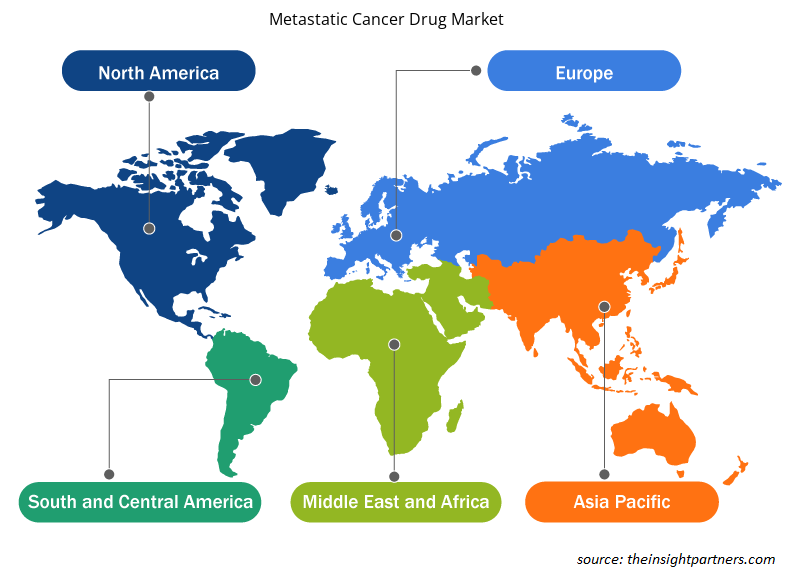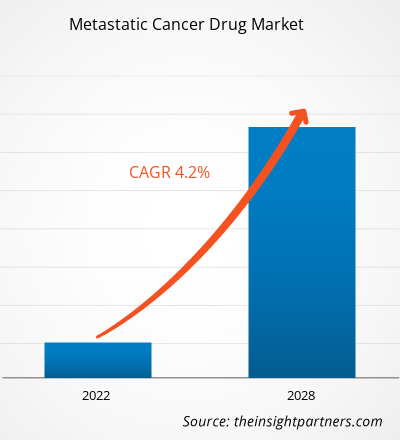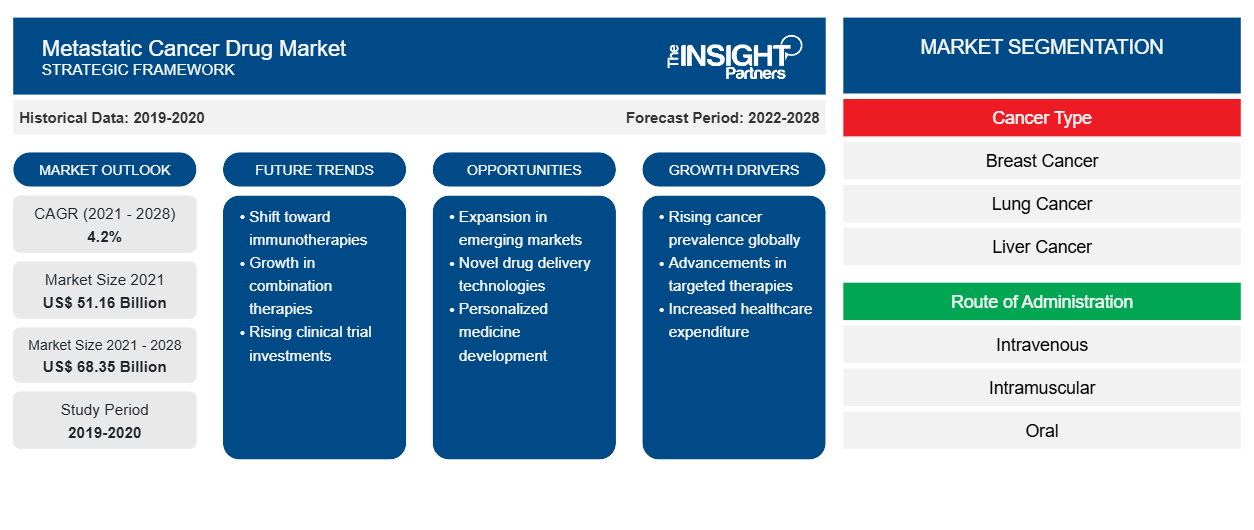[Informe de investigación] Se proyecta que el tamaño del mercado de medicamentos contra el cáncer metastásico alcance los 68.349,54 millones de dólares estadounidenses en 2028, frente a los 51.157,97 millones de dólares estadounidenses en 2021. Se espera que crezca a una CAGR del 4,2 % entre 2021 y 2028.
El cáncer metastásico se define como un cáncer en etapa avanzada que se propaga a otras partes del cuerpo, y los medicamentos que se utilizan para el tratamiento del cáncer en etapa avanzada se conocen como medicamentos contra el cáncer metastásico. Estos medicamentos se utilizan a través de diversas terapias, como quimioterapia, inmunoterapia y terapia dirigida.
El mercado de medicamentos contra el cáncer metastásico se analiza en función del tipo de cáncer, la vía de administración, la clase de medicamento, el producto, el usuario final y la geografía. El mercado, por geografía, está ampliamente segmentado en América del Norte, Europa, Asia Pacífico, Oriente Medio y África, y América del Sur y Central. El informe ofrece información y un análisis profundo del mercado, haciendo hincapié en los parámetros, como el tamaño del mercado de medicamentos contra el cáncer metastásico, las tendencias, los avances tecnológicos y la dinámica del mercado, junto con el análisis del panorama competitivo de los principales actores del mercado a nivel mundial.
Personalice este informe según sus necesidades
Obtendrá personalización en cualquier informe, sin cargo, incluidas partes de este informe o análisis a nivel de país, paquete de datos de Excel, así como también grandes ofertas y descuentos para empresas emergentes y universidades.
-
Obtenga las principales tendencias clave del mercado de este informe.Esta muestra GRATUITA incluirá análisis de datos, desde tendencias del mercado hasta estimaciones y pronósticos.
El mercado de medicamentos contra el cáncer metastásico se atribuye a la alta prevalencia del cáncer metastásico y a las iniciativas gubernamentales para apoyar los avances en el tratamiento del cáncer. Sin embargo, el alto costo de los medicamentos oncológicos restringe el crecimiento del mercado de medicamentos contra el cáncer metastásico.
Perspectivas de mercado:
alta prevalencia de cáncer metastásico
El cáncer es una de las enfermedades que más afecta a la sociedad en todo el mundo. Según los datos proporcionados por el Instituto Nacional del Cáncer, en 2020, 1.806.590 personas padecían cáncer en Estados Unidos, mientras que 606.520 personas murieron por esta enfermedad. Según el Instituto Americano de Investigación del Cáncer, en 2020, se detectaron 18.100 casos activos en todo el mundo. Además, la Organización Mundial de la Salud (OMS) afirmó que 10.000 muertes, o 1 de cada 6 muertes a nivel mundial, se debieron al cáncer. Los tipos de cáncer más comunes son el cáncer de pulmón, el cáncer de mama, el cáncer de colon, el cáncer de recto y el cáncer de próstata. La enfermedad se desarrolla en 400.000 niños cada año. Las infecciones cancerígenas, entre ellas Helicobacter pylori, el virus de la hepatitis B, el virus del papiloma humano (VPH), el virus de la hepatitis C y el virus de Epstein-Barr, causaron el 13% de los casos de cáncer en 2018 a nivel mundial. La Agencia Internacional para la Investigación sobre el Cáncer (IARC) proyecta que el número de nuevos casos de cáncer y muertes relacionadas con el cáncer en todo el mundo crecerá entre 1,6 y 1,7 veces para 2040 hasta llegar a 29,5 millones y de 16,4 millones en 2018. Además, según la Sociedad Estadounidense de Oncología Clínica, en 2021, 290.560 personas (287.850 mujeres y 2.710 hombres) en los EE. UU. fueron diagnosticadas con cáncer de mama invasivo. El cáncer de mama en mujeres ahora ha superado al cáncer de pulmón y es reconocido como el tipo de cáncer más común en todo el mundo. Aproximadamente, 2.261.419 mujeres fueron diagnosticadas con cáncer de mama en 2020.papillomavirus (HPV), hepatitis C virus, and Epstein-Barr virus—caused 13% of cancer cases in 2018, globally. The International Agency for Research on Cancer (IARC) projects that the number of new cancer cases and cancer-related deaths worldwide will grow 1.6–1.7 fold by 2040 to reach 29.5 million and from 16.4 million in 2018. Further, according to the American Society of Clinical Oncology, in 2021, 290,560 people (287,850 women and 2,710 men) in the US were diagnosed with invasive breast cancer. Breast cancer in females has now surpassed lung cancer and is recognized as the most common cancer type worldwide. Approximately, 2,261,419 women were diagnosed with breast cancer in 2020.
Entre todas las observaciones registradas sobre el cáncer en los EE. UU. durante las últimas décadas, una estadística se ha mantenido inalterada: el cáncer metastásico representa hasta el 90 % de todas las muertes por cáncer cada año. Estas cifras han motivado a los médicos e investigadores a encontrar nuevas formas de tratar la metástasis, que se produce cuando el cáncer se propaga más allá de su punto de origen. En los EE. UU., el 6 % de las mujeres fueron diagnosticadas con cáncer de mama metastásico en el primer diagnóstico. Tal aumento en la prevalencia del cáncer metastásico está impulsando el crecimiento del mercado de medicamentos contra el cáncer metastásico.
En América del Norte, se espera que Canadá sea testigo de un crecimiento considerable durante el período de pronóstico. Los principales medicamentos de inmunoterapia utilizados en Canadá son ipilimumab (Yervoy), pembrolizumab (Keytruda), nivolumab (Opdivo), durvalumab (Imfinzi) y atezolizumab (Tecentriq). Sin embargo, hay otros inhibidores de puntos de control que están preparados para impulsar el crecimiento general del mercado.immunotherapy drugs used in Canada are ipilimumab (Yervoy), pembrolizumab (Keytruda), nivolumab (Opdivo), durvalumab (Imfinzi) and atezolizumab (Tecentriq). However, there are other checkpoint inhibitors poised to bring the overall market growth.
Información basada en el tipo de cáncer
Según el tipo de cáncer, el mercado de medicamentos contra el cáncer metastásico se segmenta en cáncer de mama, cáncer de pulmón, cáncer de hígado , cáncer hematológico , cáncer de cerebro, cáncer de próstata, cáncer de páncreas y otros. El segmento del cáncer de mama representó la mayor participación de mercado en 2021 y se prevé que registre la CAGR más alta durante el período de pronóstico.CAGR during the forecast period.
Información basada en la ruta de administración
Según la vía de administración, el mercado de medicamentos contra el cáncer metastásico se segmenta en intravenoso, intramuscular, oral y otros. El segmento intravenoso representó la mayor participación de mercado en 2021 y se espera que registre la CAGR más alta durante el período de pronóstico.
Perspectivas basadas en la clase de fármacos
Según la clase de fármaco, el mercado de fármacos contra el cáncer metastásico se segmenta en inhibidores de HER2, inhibidores de puntos de control inmunitarios , inhibidores de PARP, inhibidores de quinasas y otros. El segmento de inhibidores de PARP representó la mayor participación de mercado en 2021. Sin embargo, se espera que el segmento de inhibidores de HER2 registre la CAGR más alta durante el período de pronóstico.
Perspectivas regionales del mercado de medicamentos contra el cáncer metastásico
Los analistas de Insight Partners explicaron en detalle las tendencias y los factores regionales que influyen en el mercado de medicamentos contra el cáncer metastásico durante el período de pronóstico. Esta sección también analiza los segmentos y la geografía del mercado de medicamentos contra el cáncer metastásico en América del Norte, Europa, Asia Pacífico, Oriente Medio y África, y América del Sur y Central.

- Obtenga datos regionales específicos para el mercado de medicamentos contra el cáncer metastásico
Alcance del informe sobre el mercado de medicamentos contra el cáncer metastásico
| Atributo del informe | Detalles |
|---|---|
| Tamaño del mercado en 2021 | US$ 51,16 mil millones |
| Tamaño del mercado en 2028 | US$ 68,35 mil millones |
| CAGR global (2021-2028) | 4,2% |
| Datos históricos | 2019-2020 |
| Período de pronóstico | 2022-2028 |
| Segmentos cubiertos |
Por tipo de cáncer
|
| Regiones y países cubiertos |
América del norte
|
| Líderes del mercado y perfiles de empresas clave |
|
Densidad de actores del mercado de medicamentos contra el cáncer metastásico: comprensión de su impacto en la dinámica empresarial
El mercado de medicamentos contra el cáncer metastásico está creciendo rápidamente, impulsado por la creciente demanda de los usuarios finales debido a factores como la evolución de las preferencias de los consumidores, los avances tecnológicos y una mayor conciencia de los beneficios del producto. A medida que aumenta la demanda, las empresas amplían sus ofertas, innovan para satisfacer las necesidades de los consumidores y aprovechan las tendencias emergentes, lo que impulsa aún más el crecimiento del mercado.
La densidad de actores del mercado se refiere a la distribución de las empresas o firmas que operan dentro de un mercado o industria en particular. Indica cuántos competidores (actores del mercado) están presentes en un espacio de mercado determinado en relación con su tamaño o valor total de mercado.
Las principales empresas que operan en el mercado de medicamentos contra el cáncer metastásico son:
- Compañía: AbbVie Inc.
- Compañía Inc.
- Compañía Bristol-Myers Squibb
- F. HOFFMANN-LA ROCHE LTD.
- Novartis AG
Descargo de responsabilidad : Las empresas enumeradas anteriormente no están clasificadas en ningún orden particular.

- Obtenga una descripción general de los principales actores clave del mercado de medicamentos contra el cáncer metastásico
Perspectivas basadas en productos
Según el producto, el mercado de medicamentos contra el cáncer metastásico se divide en medicamentos de marca, genéricos y biosimilares. El segmento de marca representó una mayor participación de mercado en 2021. Sin embargo, se estima que el segmento de genéricos y biosimilares registrará una CAGR más alta durante el período de pronóstico.
Información basada en el usuario final
Según el usuario final, el mercado de medicamentos contra el cáncer metastásico se segmenta en hospitales, clínicas especializadas y otros. El segmento hospitalario representó la mayor participación en 2021, mientras que se estima que el segmento de clínicas especializadas registrará la CAGR más alta durante el período de pronóstico.
Los lanzamientos y aprobaciones de productos se encuentran entre las estrategias que suelen adoptar las empresas para ampliar su presencia global y sus carteras de productos. Los actores del mercado de medicamentos contra el cáncer metastásico también se centran en la estrategia de asociación para ampliar su clientela, lo que, a su vez, les permite mantener su marca en todo el mundo. Su objetivo es aumentar sus cuotas de mercado con el desarrollo de productos innovadores.
AbbVie Inc.; Amgen Inc.; Bristol-Myers Squibb Company; F. HOFFMANN-LA ROCHE LTD.; Novartis AG; ASTRAZENECA PLC.; Eli Lilly and Company; MERCK KGaA; y Pfizer Inc. (Arena Pharmaceutical GmbH); y Johnson and Johnson Services, Inc. son las empresas líderes que operan en el mercado de medicamentos contra el cáncer metastásico.
- Análisis histórico (2 años), año base, pronóstico (7 años) con CAGR
- Análisis PEST y FODA
- Tamaño del mercado, valor/volumen: global, regional y nacional
- Industria y panorama competitivo
- Conjunto de datos de Excel
Informes recientes
Informes relacionados
Testimonios
Razón para comprar
- Toma de decisiones informada
- Comprensión de la dinámica del mercado
- Análisis competitivo
- Información sobre clientes
- Pronósticos del mercado
- Mitigación de riesgos
- Planificación estratégica
- Justificación de la inversión
- Identificación de mercados emergentes
- Mejora de las estrategias de marketing
- Impulso de la eficiencia operativa
- Alineación con las tendencias regulatorias























 Obtenga una muestra gratuita para - Mercado de medicamentos contra el cáncer metastásico
Obtenga una muestra gratuita para - Mercado de medicamentos contra el cáncer metastásico